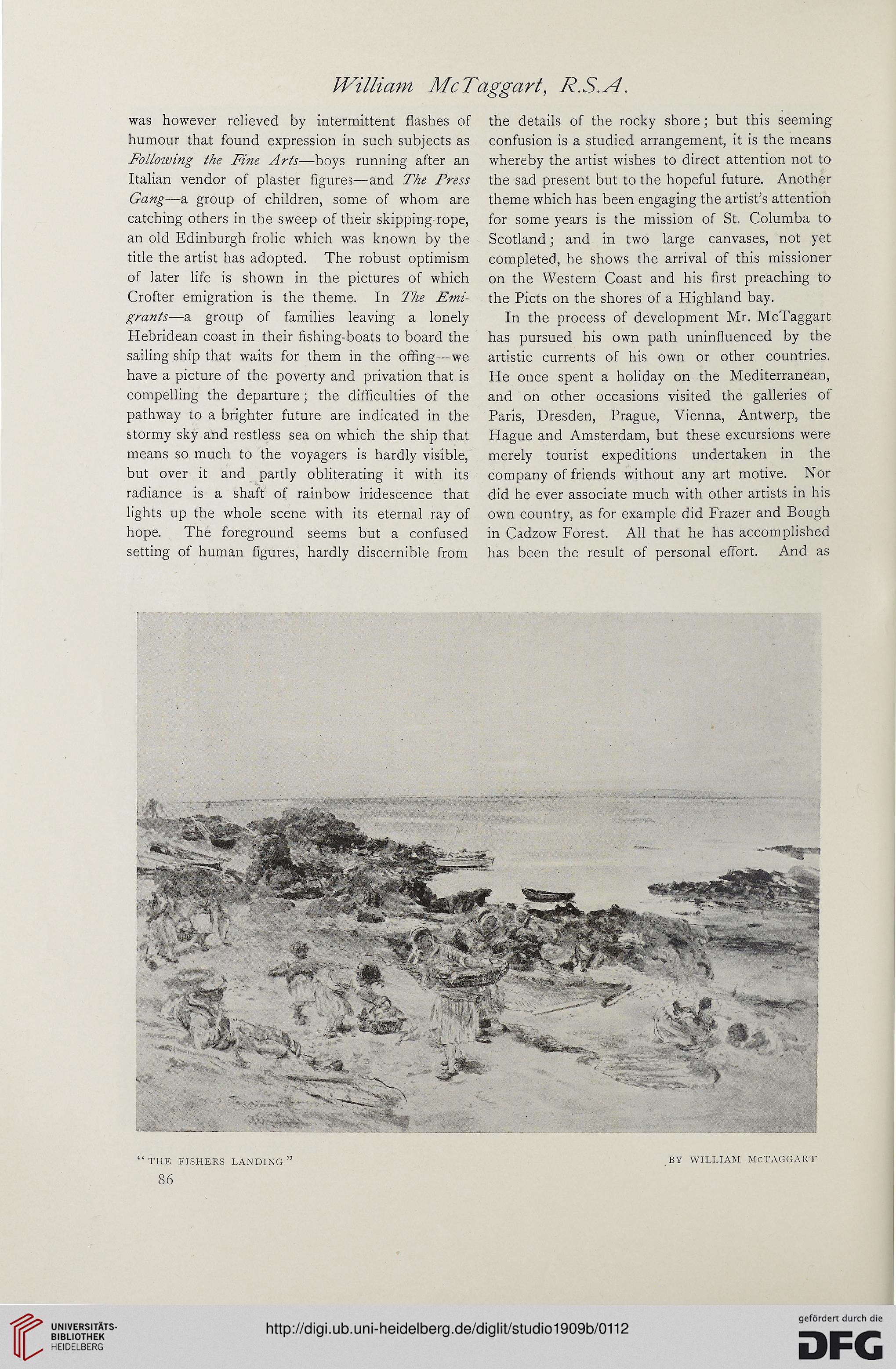William McTaggart, R.S.A.
was however relieved by intermittent flashes of
humour that found expression in such subjects as
Following the Fine Arts—boys running after an
Italian vendor of plaster figures—and The Press
Gang—a group of children, some of whom are
catching others in the sweep of their skipping-rope,
an old Edinburgh frolic which was known by the
title the artist has adopted. The robust optimism
of later life is shown in the pictures of which
Crofter emigration is the theme. In The Emi-
grants—a group of families leaving a lonely
Hebridean coast in their fishing-boats to board the
sailing ship that waits for them in the offing—we
have a picture of the poverty and privation that is
compelling the departure; the difficulties of the
pathway to a brighter future are indicated in the
stormy sky and restless sea on which the ship that
means so much to the voyagers is hardly visible,
but over it and partly obliterating it with its
radiance is a shaft of rainbow iridescence that
lights up the whole scene with its eternal ray of
hope. The foreground seems but a confused
setting of human figures, hardly discernible from
the details of the rocky shore; but this seeming
confusion is a studied arrangement, it is the means
whereby the artist wishes to direct attention not to
the sad present but to the hopeful future. Another
theme which has been engaging the artist’s attention
for some years is the mission of St. Columba to
Scotland; and in two large canvases, not yet
completed, he shows the arrival of this missioner
on the Western Coast and his first preaching to
the Piets on the shores of a Highland bay.
In the process of development Mr. McTaggart
has pursued his own path uninfluenced by the
artistic currents of his own or other countries.
He once spent a holiday on the Mediterranean,
and on other occasions visited the galleries of
Paris, Dresden, Prague, Vienna, Antwerp, the
Hague and Amsterdam, but these excursions were
merely tourist expeditions undertaken in the
company of friends without any art motive. Nor
did he ever associate much with other artists in his
own country, as for example did Frazer and Bough
in Cadzow Forest. All that he has accomplished
has been the result of personal effort. And as
“the fishers landing
86
BY WILLIAM MCTAGGART
was however relieved by intermittent flashes of
humour that found expression in such subjects as
Following the Fine Arts—boys running after an
Italian vendor of plaster figures—and The Press
Gang—a group of children, some of whom are
catching others in the sweep of their skipping-rope,
an old Edinburgh frolic which was known by the
title the artist has adopted. The robust optimism
of later life is shown in the pictures of which
Crofter emigration is the theme. In The Emi-
grants—a group of families leaving a lonely
Hebridean coast in their fishing-boats to board the
sailing ship that waits for them in the offing—we
have a picture of the poverty and privation that is
compelling the departure; the difficulties of the
pathway to a brighter future are indicated in the
stormy sky and restless sea on which the ship that
means so much to the voyagers is hardly visible,
but over it and partly obliterating it with its
radiance is a shaft of rainbow iridescence that
lights up the whole scene with its eternal ray of
hope. The foreground seems but a confused
setting of human figures, hardly discernible from
the details of the rocky shore; but this seeming
confusion is a studied arrangement, it is the means
whereby the artist wishes to direct attention not to
the sad present but to the hopeful future. Another
theme which has been engaging the artist’s attention
for some years is the mission of St. Columba to
Scotland; and in two large canvases, not yet
completed, he shows the arrival of this missioner
on the Western Coast and his first preaching to
the Piets on the shores of a Highland bay.
In the process of development Mr. McTaggart
has pursued his own path uninfluenced by the
artistic currents of his own or other countries.
He once spent a holiday on the Mediterranean,
and on other occasions visited the galleries of
Paris, Dresden, Prague, Vienna, Antwerp, the
Hague and Amsterdam, but these excursions were
merely tourist expeditions undertaken in the
company of friends without any art motive. Nor
did he ever associate much with other artists in his
own country, as for example did Frazer and Bough
in Cadzow Forest. All that he has accomplished
has been the result of personal effort. And as
“the fishers landing
86
BY WILLIAM MCTAGGART




